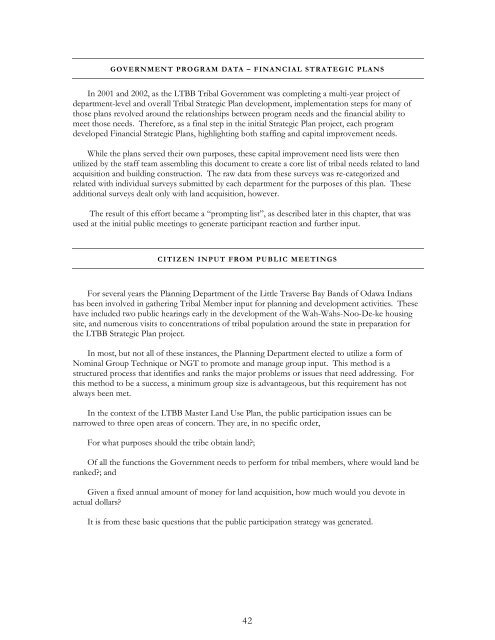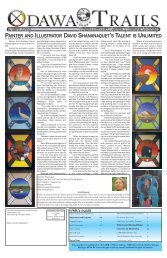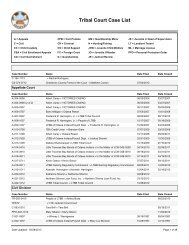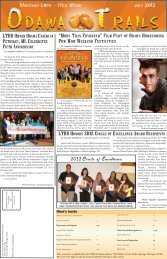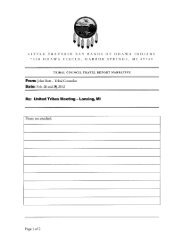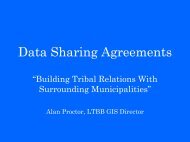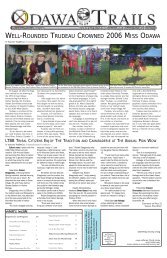LTBB Master Land Use Plan - Little Traverse Bay Bands of Odawa ...
LTBB Master Land Use Plan - Little Traverse Bay Bands of Odawa ...
LTBB Master Land Use Plan - Little Traverse Bay Bands of Odawa ...
You also want an ePaper? Increase the reach of your titles
YUMPU automatically turns print PDFs into web optimized ePapers that Google loves.
GOVERNMENT PROGRAM DATA – FINANCIAL STRATEGIC PLANS<br />
In 2001 and 2002, as the <strong>LTBB</strong> Tribal Government was completing a multi-year project <strong>of</strong><br />
department-level and overall Tribal Strategic <strong>Plan</strong> development, implementation steps for many <strong>of</strong><br />
those plans revolved around the relationships between program needs and the financial ability to<br />
meet those needs. Therefore, as a final step in the initial Strategic <strong>Plan</strong> project, each program<br />
developed Financial Strategic <strong>Plan</strong>s, highlighting both staffing and capital improvement needs.<br />
While the plans served their own purposes, these capital improvement need lists were then<br />
utilized by the staff team assembling this document to create a core list <strong>of</strong> tribal needs related to land<br />
acquisition and building construction. The raw data from these surveys was re-categorized and<br />
related with individual surveys submitted by each department for the purposes <strong>of</strong> this plan. These<br />
additional surveys dealt only with land acquisition, however.<br />
The result <strong>of</strong> this effort became a “prompting list”, as described later in this chapter, that was<br />
used at the initial public meetings to generate participant reaction and further input.<br />
CITIZEN INPUT FROM PUBLIC MEETINGS<br />
For several years the <strong>Plan</strong>ning Department <strong>of</strong> the <strong>Little</strong> <strong>Traverse</strong> <strong>Bay</strong> <strong>Bands</strong> <strong>of</strong> <strong>Odawa</strong> Indians<br />
has been involved in gathering Tribal Member input for planning and development activities. These<br />
have included two public hearings early in the development <strong>of</strong> the Wah-Wahs-Noo-De-ke housing<br />
site, and numerous visits to concentrations <strong>of</strong> tribal population around the state in preparation for<br />
the <strong>LTBB</strong> Strategic <strong>Plan</strong> project.<br />
In most, but not all <strong>of</strong> these instances, the <strong>Plan</strong>ning Department elected to utilize a form <strong>of</strong><br />
Nominal Group Technique or NGT to promote and manage group input. This method is a<br />
structured process that identifies and ranks the major problems or issues that need addressing. For<br />
this method to be a success, a minimum group size is advantageous, but this requirement has not<br />
always been met.<br />
In the context <strong>of</strong> the <strong>LTBB</strong> <strong>Master</strong> <strong>Land</strong> <strong>Use</strong> <strong>Plan</strong>, the public participation issues can be<br />
narrowed to three open areas <strong>of</strong> concern. They are, in no specific order,<br />
For what purposes should the tribe obtain land?;<br />
Of all the functions the Government needs to perform for tribal members, where would land be<br />
ranked?; and<br />
Given a fixed annual amount <strong>of</strong> money for land acquisition, how much would you devote in<br />
actual dollars?<br />
It is from these basic questions that the public participation strategy was generated.<br />
42


